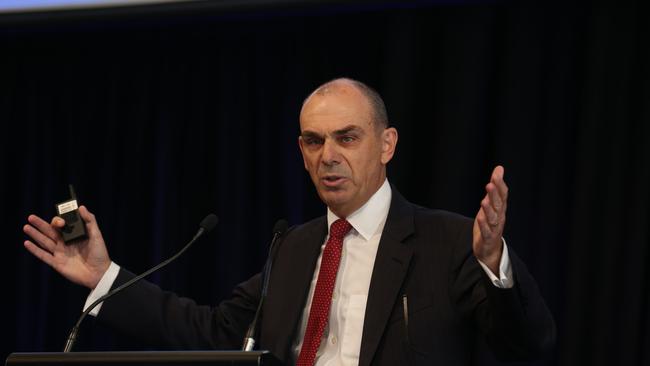APRA’s Wayne Byres gives banks a break on lending

If anything, the prudential regulator’s surprise announcement suggests that the market is weaker than previously thought.
As recently as January, APRA was still beating the drum about disciplined lending.
It said tactical measures that were introduced, like the requirement to assess loan serviceability using the higher of a 7 per cent interest-rate floor or a 2 per cent buffer over the loan’s interest rate, were “intended to be permanent”.
The agency backed it up less than a month later, reminding banks that sound lending standards had to be applied through the cycle, “regardless of whether housing prices are rising, falling or moving sideways”.
All those stern warnings now seem to have been cast aside.
While growth in home lending is fading and property prices continue to retreat, it’s hardly the kind of disaster that would call for a rapid policy U-turn, unless things are worse than we’re led to believe.
APRA’s current guidance is that banks should assess whether borrowers can afford their repayments using a minimum interest rate of 7 per cent or a 2 per cent buffer over the loan’s interest rate, whichever is higher.
It says a prudent lender should use rates comfortably higher than those benchmarks.
Most of the industry factors in a minimum rate of 7.25 per cent and a buffer of 2.25 per cent.
But now, all of a sudden, the regulator is proposing that banks come up with their own minimum interest-rate floor and use an interest rate buffer of 2.5 per cent.
In practice, with most mortgages paying interest of about 4 per cent, this would reduce the serviceability floor by 75 basis points from 7.25 per cent to 6.5 per cent.
Magically, borrowing capacity goes up, with the banks previously indicating that any 1 per cent reduction in the floor increases borrowing capacity by 10 per cent.
If there are two official interest rate cuts in the pipeline, as most of the market assumes, that figure increases further, particularly if the banks fold under inevitable pressure from the Morrison government to pass on each 25 basis-point cut in full.
That said, the final impact of the changes will by offset by the scale-up of expense and income verification required by the financial services royal commission, and the reality that only 10 per cent of home loan customers borrow the maximum amount.
APRA’s justification for the policy switch is plausible.
It says the serviceability guidance was first introduced in December 2014 to reinforce the need for sound residential lending standards, with the interest rate floor and buffer limiting excessive borrowing when rates were low and household debt was high.
While many of the risk factors are still here, APRA chairman Wayne Byres says two recent developments have led to a review of the interest rate floor.
First, rates are at a record low and likely to stay that way for some time, so the gap between the 7 per cent floor and actual rates paid has become very wide.
Also, the introduction of differential rates for owner-occupiers and investors has undermined the logic behind a single floor rate across all products. “The changes, while likely to increase the maximum borrowing capacity for a given borrower, are not intended to signify any lessening in the importance that APRA places on the maintenance of sound lending standards,” Byres says.
Unsurprisingly, the market welcomed the move.
It’s been a long time since the banks have enjoyed two consecutive days of surprise good news.



APRA’s plan to remove its serviceability floor on mortgages frees up borrowing capacity but raises an important question: what is the real state of the housing market?